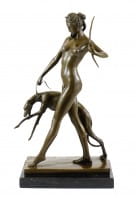Venus
The term "Venus" in art generally refers to a type of statuary that emerged during the Upper Paleolithic period and typically continued into the Classical era of Greece and Rome. These sculptures depict female figures and are often associated with fertility, beauty, and the concept of the divine feminine. There are many famous examples of these kinds of sculptures.
- Venus figurines of the Paleolithic: These are small statuettes of women, typically with exaggerated sexual features, made during the Upper Paleolithic period. One of the most famous of these is the Venus of Willendorf, a figurine carved from limestone and believed to be made around 30,000–25,000 BCE. These figurines are interpreted as possibly being fertility symbols.
- Venus in Classical Art: The term Venus also refers to the Roman goddess of love, beauty, desire, and fertility, who was the equivalent of the Greek goddess Aphrodite. Many sculptures were made of Venus/Aphrodite during the Classical period in Greece and the Roman era. These sculptures often highlight beauty and the feminine form, and Venus was a popular subject for many renowned artists of the time.
One famous example is the Venus de Milo, an ancient Greek statue currently housed in the Louvre Museum in Paris. This statue, made of marble and standing about two meters tall, was created sometime between 130 and 100 BCE. It is celebrated for its beauty and mystery, especially considering it was discovered missing its arms.
Another is the Venus of Urbino, which is not a sculpture but a painting by Titian, an Italian master of the 16th century. This work is renowned for its sensual depiction of the female form.
Venus in Contemporary Art: Contemporary artists may also create works inspired by or responding to these historical depictions of Venus. These may critique, uphold, or explore in new ways the themes of femininity, beauty, and desire associated with Venus.
In all these instances, Venus serves as a central figure in the understanding of femininity and female beauty throughout the history of art.


















































